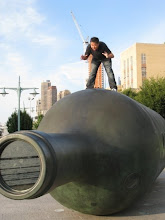The future of urban living exists in mixed use developments where vertical circulation, and pedestrian friendly buildings allow for an e efficient living community.
The majority of growth in the world is occurring in cities; urban centers are expanding as people are moving in from their rural surroundings. With this expansion, there is a greater pressure for higher e efficiency, as well as greater need to maintain a healthy community environment. They must perform a variety of roles to accomodate the needs of a rapid, constant, high paced society, and do so with a strong consideration of the global environment.
NEIGHBORHOODS

MAJOR ROADS
 SUBWAY
SUBWAY FERRY
FERRY POTENTIAL SITES AND NODES
POTENTIAL SITES AND NODES PRECEDENCE
PRECEDENCE





 This photograph was taken during the summer at a camp in upstate new york. It shows a type of play in an outdoor setting away for the dense urban grid.
This photograph was taken during the summer at a camp in upstate new york. It shows a type of play in an outdoor setting away for the dense urban grid.





